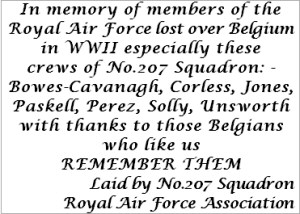 |
207 SQUADRON ROYAL AIR FORCE HISTORY207 Squadron RAF Association
|
 |
We visited this long-established Provincial Memorial to those of the Royal Air Forces who fell in Limburg in the cause of freedom, to lay a wreath to the crews of 207 Squadron who came down in Belgium. It was a very wet Saturday morning.
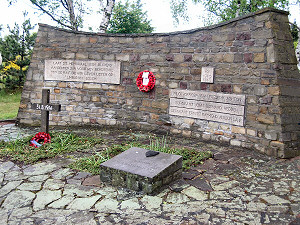 Three crew from a 101 Sqn Wellington died very close to here on 31 Aug 1941 |
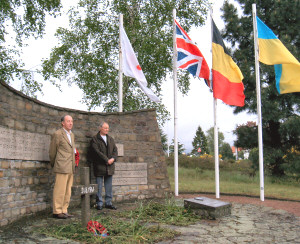 Mr Timmermans (left), curator of the memorial, and a colleague put the flags out for us |
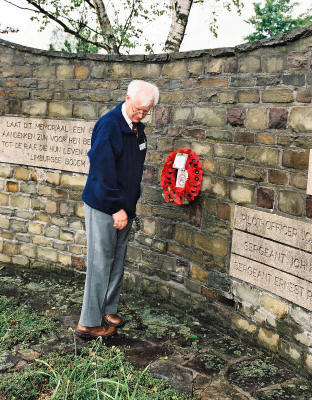 Membership Secretary Frank Haslam jr has just placed the wreath on the memorial |
Frank's laying of the wreath continued a family and 207 link with this memorial. Association members Arthur Barton (F/E, Solly crew) and Frank Haslam snr (W/Op, Solly crew) both evaded; Frank snr was also a post war ex-101 Sqn). The Haslams were invited by the Memorial Committee to lay a wreath at the memorial in 1981. Friend member Leon Reumers, related by marriage to the family which hid Frank snr in nearby Wiemesmeer, was one of the stonemasons who worked on the memorial |
HISTORY OF THE ROYAL AIR FORCE PROVINCIAL MEMORIAL
On May 10th 1940 the German forces entered Belgian territory and forced surrender within 18 days. The captured Belgian soldiers were deported to Germany, as well as members of other groups, such as those who refused to carry out work, members of patriotic societies and ethnic groups. Deportees had to work in Germany in the war industry. A small proportion was employed in the agricultural sector to take the place of Germans called up for military service.
Groups were founded secretly to make the German occupation more difficult. They collected information on troop movements and defence works and this information was sent to England. The occupation was also hampered by acts of sabotage.
To counter Allied bombing, in the east of Belgium searchlights were installed by the Germans to work with flak batteries. Half a dozen of these searchlights were put up within the city limits of Genk. Near to these searchlights there were always several anti-aircraft guns. One of these searchlights was put up in the neighbourhood of Boxbergheide, and this where now Winterslag's 4th Cité (former lodgings of migrant miners) is situated, near to the current Lindestraat. Otherwise Boxbergheide was a vast plain of heather with a few scattered farms.
On August 31st 1941 7 aircraft of No. 101 Squadron RAF, based at RAF Oakington, Cambridgeshire, were briefed at 17h30 as part of a Bomber Command raid on Cologne, with another 2 aircraft ready in reserve. The planes were loaded with incendiaries, 3 heavy bombs of 500lbs and one of 250 lbs.
P/O JF Ashton's crew, in ' A ' Flight, were flying in Wellington Mk1C R1703 SR-J:
| Pilot: P/O John Frederick
Ashton + 2nd Pilot: Sgt RT Wood RCAF pow Observer: Sgt Ernest Raymond Verdun Lane + Wireless Op: Sgt John Bernard Redden RCAF + Air Gunner: Sgt LA Warburton evd Air Gunner: Sgt JW Hutton evd |
t/o 2014
Oakington, crashed at Boxbergheide (Limburg) in the
western suburbs of Genk, Belgium. Those who died are
buried in Schaffen Communal
Cemetery, at Diest, in
collective grave 11. based on : RAF Bomber Command Losses of the Second World War 1941, WR Chorley (Midland Counties Publishing, 1993) |
On the way back from Germany the bomber was attacked by German fighters and was shot ablaze by anti-aircraft guns. The bomber first flew over Boxbergheide in the direction of England and then returned. Although the Wellington could absorb much damage R1703 lost several parts: part of the wing fell in the Congostraat in the garden of the Thys family, as well as an engine, which fell on the premises of Jan Bollen's farm in Boxbergheide, near to where we can now find the Kievitstraat.
Three crew members - Sgt Wood, Sgt Warburton and Sgt. Hutton - were able to bale out and they were taken care of by members of the local resistance which brought these men back to England via escape routes through France, Spain and Portugal.
The other three crew members were killed - the plane catching fire when it crashed. After the fire nothing of the plane was left but a few scattered pieces of wreckage. The occupying forces arrived quickly and buried the three killed airmen on the spot.
At first the graves in the heather were bordered with stones and a cross was made of white stones. These graves were constantly wilfully destroyed by the Hitler Youth, but again and again they were restored by dissident people and by local young people. Already in those days flowers were often put on the graves, not only by Miss Jeanne Dries, who regularly plundered the bushes at home, but also by Mrs. Leonie Decosemaker-Thoelen who ran a shop in the Winterslagstraat in Genk.
A short time after the aeroplane had crashed, a wooden cross was put on the spot by the Glowacki-Plocinnik family, originating from Ikern in Poland. Mrs. Antonie Plocinnik was expecting their son Jan, born on the 25th October 1941. The wooden cross which was put there was made of burnt wood and its horizontal beam had the shape of an aeroplane's propeller.
This wooden cross stayed there until all of a sudden a concrete cross, provided in the year 1943 was put in its place. This concrete cross had been made secretly in the Winterslag mine by the employees. It was on a dark late night between 10pm and 11pm that the cross was put in its place by its producer Mr and Mrs François Beelen, assisted by Mr and Mrs Pierre Reiss from the mine's drawing office.
At that time Mr Beelen was head of the production department of the Winterslag mine, and he also made the crosses that were put on the graves of Russian prisoners of war that had died during their work in the underground workings. This was during the time of occupation by the Germans and one can imagine the danger to which these people exposed themselves - a concrete cross is not easily hidden under a coat.
During a visit by 207 Squadron RAF Association in May 2005, Mr Timmermans, curator of the Memorial, explained that the concrete cross was repeatedly removed by the Germans and a new one put in place by the miners, but eventually the Germans gave up and it stayed in place.
During the occupation Miss Daisy Gielen successfully wrote to the Red Cross in order to find out the names of the fallen airmen. She was also involved in the escape routes. After we had been liberated in 1944 and after Germany's capitulation in 1945 flowers were frequently put on the graves by local children.
A few years later a committee was founded with Miss Gielen, Frans Bielen and Jean Loix, who became the committee's first president. Together with Mr Albert Taylor's help this committee started to think in terms of a lasting commemoration.
The three fallen airmen were relocated by the British services to Schaffen where there is a military cemetery and where a ceremony is held each year to commemorate the fallen soldiers.
In total 127 Britons, 45 Canadians, 14 Australians, 3 New Zealanders, 3 South Africans and 1 Belgian in the Royal Air Forces died on Limburg soil for our liberation.
| It was thought at that moment to put up a memorial by means of which we could commemorate these people. The parish priest, Michel Boonen, also played a very active role in the endeavours to put up the monument. The committee got into contact with ecclesiastical, civil and military institutions to come to an agreement. Several drafts were produced and finally the draft of Raf Mailleux, artist-sculptor, was accepted. It was for a memorial using moelonstone with a wall length of 6.80m (22ft 4") and a height of 2.20m (7ft 4") in an area of 42m² (160 square feet). For the foundations 12.80m³ of concrete was used. The front garden partly consists of plants and flat stones. The illumination is switched on and off together with the street lighting. The monument was built by three local volunteers whose names are carved in the back of the monument. | 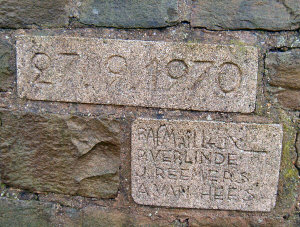 |
The construction was made possible as the piece of land was put at the committee's disposal by the churchwardens. Materials and transport were paid for by the municipality of Genk. There was also a close collaboration with provincial, municipal, military, ecclesiastical and civil institutions. Honorary membership cards were sold at BF 2,000 (about £30) each.
The memorial was inaugurated on September 27th 1970, in the presence of a delegate of King Baudouin, a delegate of the British Embassy, the Marshal of the Royal Air Force, the Commander-in-chief of the Allied Forces in Germany and Central Europe, and the RAF's Commander-in-chief in Germany. Highly placed Belgian officials - ecclesiastical, civil as well as military - were also present at the ceremony. Even RAF Germany's Standard, just presented by HRH Princess Anne, was present.
Members of the 10th Wing at Kleine Brogel and the complete RAF Germany Band were present. Starfighters of the Belgian Air Force and RAF Harriers together did a fly past over the memorial. The ceremony ended with parachutists from Schaffen dropping from a helicopter and mustering afterwards to lay a floral tribute to the three airmen.
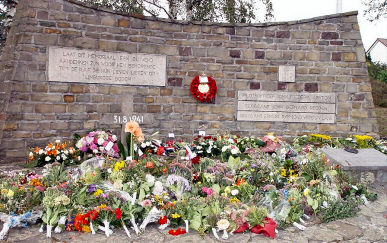 |
Bouquets and wreaths
were laid at the memorial by the above-mentioned
personalities, and by patriotic societies, the
Resistance and War veterans. Flowers were also put at
the monument by pupils of the local primary school. Every year on the second Tuesday of September a similar ceremony takes place which is attended by many personalities, as well as by the war veterans' United Front of the municipality of Genk, together with some 400 local children. |
| According to Mr Timmermans, these
days many of the children can say that their parents
and grandparents came when they were children and so
the memorial has treasured place in the heart of the
local community. Also present each year is a party from 101 Squadron RAF, with their standard and an RAF Band. 101 Squadron lost in all 1,140 crewmen during WW2, for country and for freedom. On the 2nd Wednesday of September, the day after the official ceremony, it is the small ones who do their bit. That day the four-year-old and five-year-old local children lay their floral tributes their way |
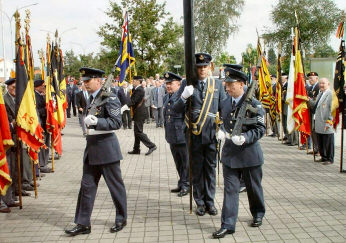 101 Squadron cased Standard marched in, amid many |
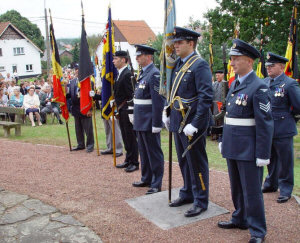 101 Sqn Colour Party at the Memorial |
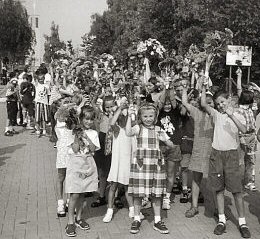 generations of local children have now laid their flowers |
| The second Tuesday in
September was chosen especially for this occasion
because the heather should be in bloom at that time
of year and one goes quiet at the sight of the
beautiful harmony between the memorial and scenery. The location of the present memorial is not the actual place where the aeroplane crashed - the memorial is situated a bit further up the hill. In the late 1980s there were fly pasts over the memorial by a 101 Sqn VC10 K.2. The 1989 Het Heidekruisje booklet about the memorial on which the above account is based ends "A nation that honours its dead is a great nation. Keeping this proverb in mind, it has to be an incentive for us to continue along the same lines." |
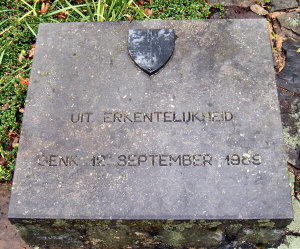 |
In 2005 it looked as if the annual gathering at the Memorial might no longer continue as the organising committee were mostly now elderly. However discussions between 101 Squadron and the Belgian Air Force base at Kleine Brogel have resulted in Kleine Brogel coming to an arrangement with the municipality and a new, younger committee has been formed. For a report on the 2006 event please click on 101 Boxbergheide 2006 Report.
LINKS
101 Squadron RAF
101 Squadron RAF Association
207
Squadron RAF History
image sources: Haslam, Reumers, 101 Sqn Association
last update 18 Sep 06: 26 Dec 13
